Abstract
Assessed is a large-scale iron supplementation programme for the 70 000 pregnant refugee women cared for by the United Nations Relief and Works Agency for Palestine Refugees in the Near East (UNRWA). For this purpose, a retrospective survey of 1267 antenatal records was conducted in health centres located in the West Bank, Gaza, Syrian Arab Republic, Jordan, and Lebanon. The following operational problems were identified: late entry to antenatal care; high drop-out rate from antenatal care; low compliance in follow-up haemoglobin examinations; and misdirected continued testing of women who were not anaemic at registration. Routine iron supplementation of all pregnant women should be considered only in those countries where severe anaemia is prevalent and should always be coupled with additional interventions that are effective at improving iron deficiency anaemia in a given population. In most countries attention should be directed towards changing dietary habits to enhance the availability of local foodstuffs that are rich in iron. One initial haemoglobin test may help in focusing on the relatively few initially anaemic subjects who need further attention. Repeated testing during pregnancy is unwarranted.
Full text
PDF
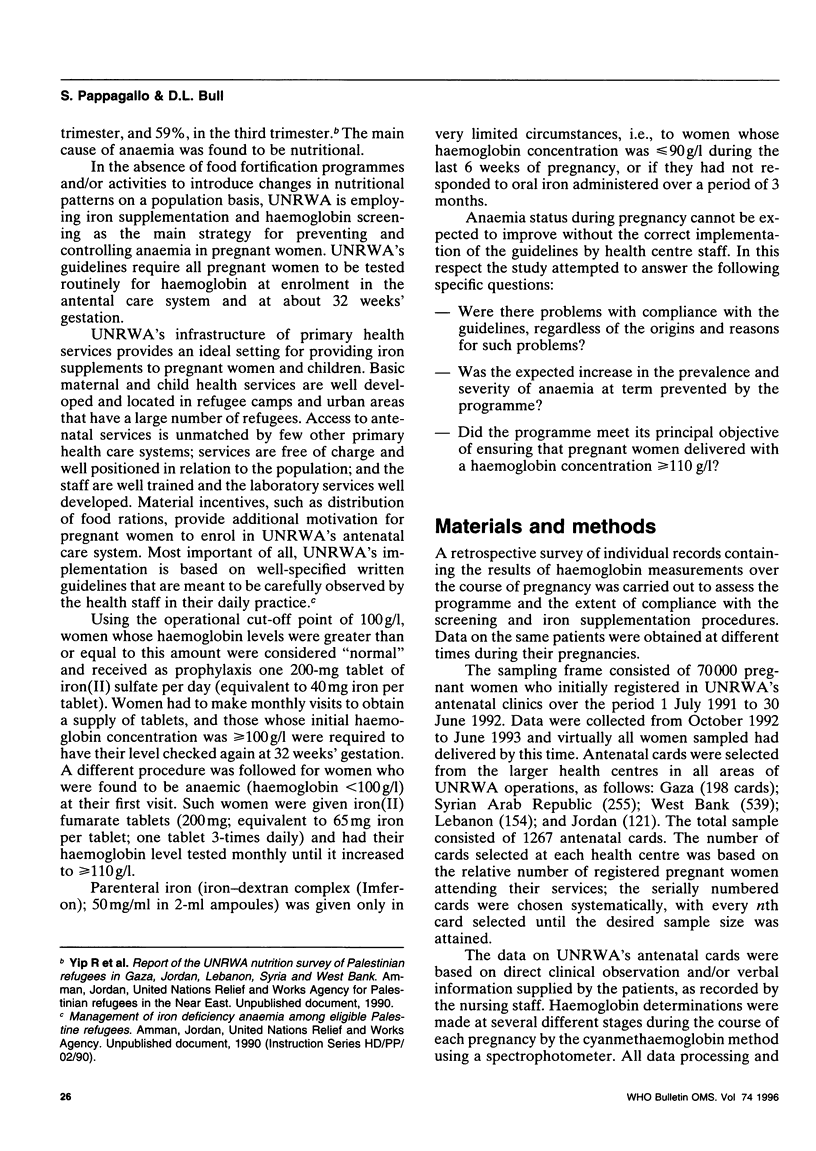
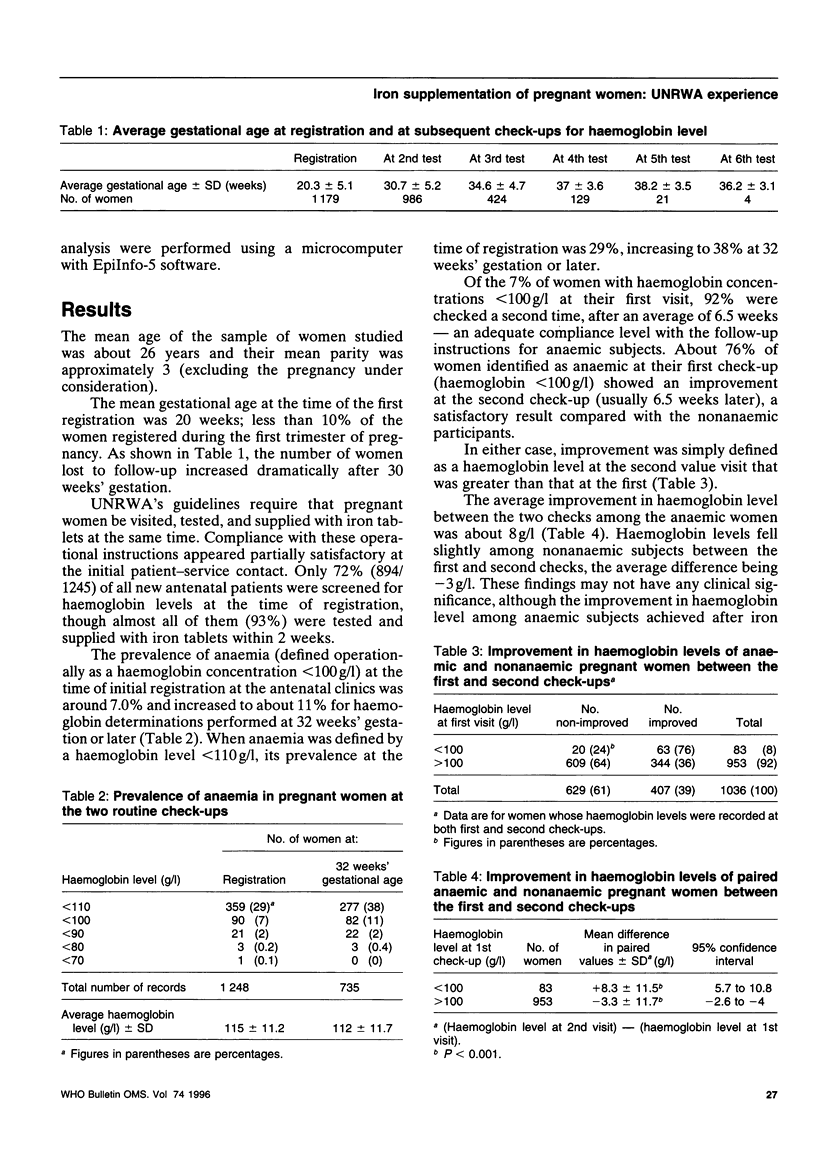
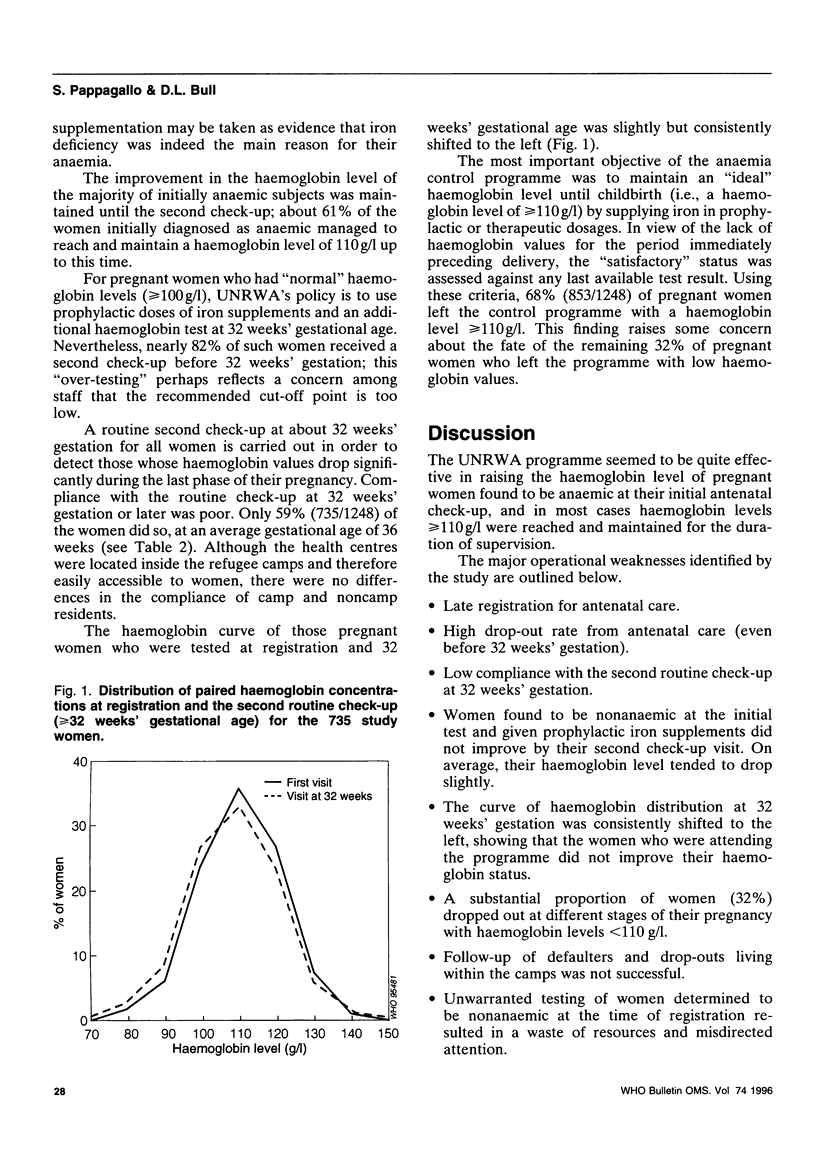


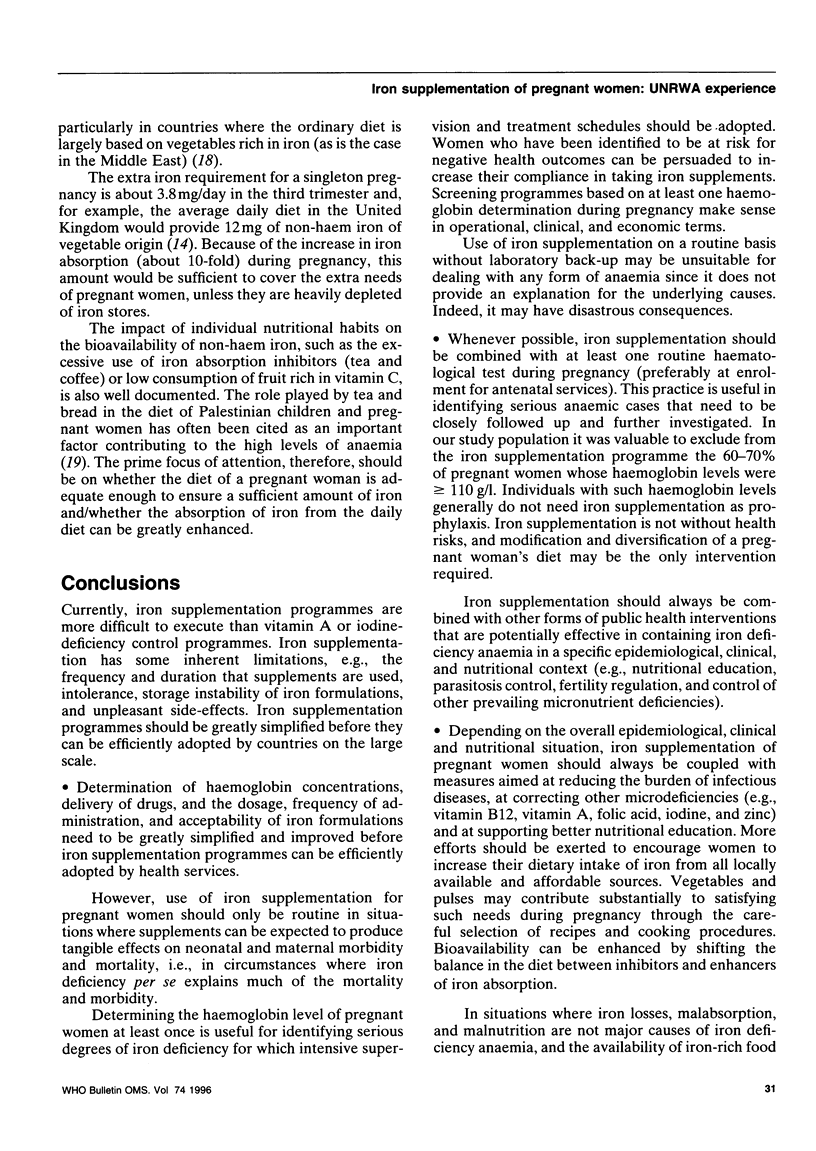
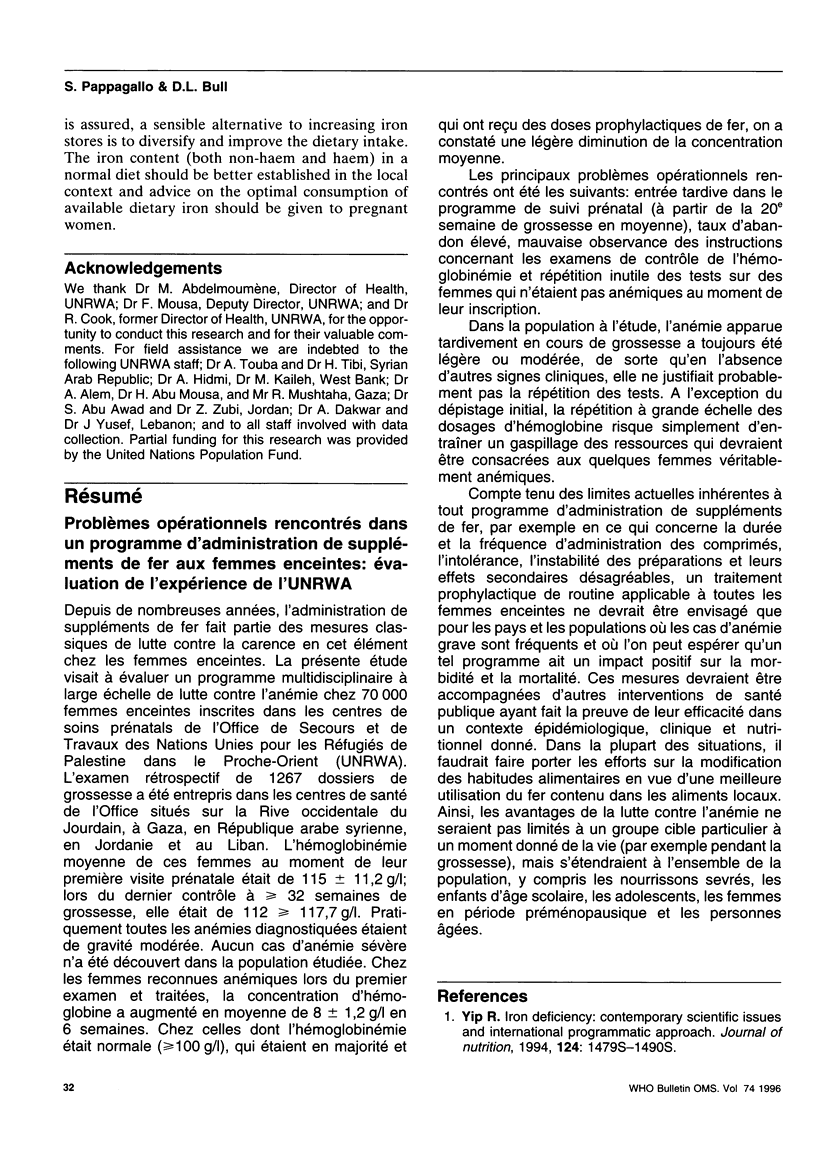

Selected References
These references are in PubMed. This may not be the complete list of references from this article.
- Atukorala T. M., de Silva L. D., Dechering W. H., Dassenaeike T. S., Perera R. S. Evaluation of effectiveness of iron-folate supplementation and anthelminthic therapy against anemia in pregnancy--a study in the plantation sector of Sri Lanka. Am J Clin Nutr. 1994 Aug;60(2):286–292. doi: 10.1093/ajcn/60.2.286. [DOI] [PubMed] [Google Scholar]
- Bhargava M., Iyer P. U., Kumar R., Ramji S., Kapani V., Bhargava S. K. Relationship of maternal serum ferritin with foetal serum ferritin, birth weight and gestation. J Trop Pediatr. 1991 Aug;37(4):149–152. doi: 10.1093/tropej/37.4.149. [DOI] [PubMed] [Google Scholar]
- Brabin B. J., Ginny M., Sapau J., Galme K., Paino J. Consequences of maternal anaemia on outcome of pregnancy in a malaria endemic area in Papua New Guinea. Ann Trop Med Parasitol. 1990 Feb;84(1):11–24. doi: 10.1080/00034983.1990.11812429. [DOI] [PubMed] [Google Scholar]
- Colomer J., Colomer C., Gutierrez D., Jubert A., Nolasco A., Donat J., Fernandez-Delgado R., Donat F., Alvarez-Dardet C. Anaemia during pregnancy as a risk factor for infant iron deficiency: report from the Valencia Infant Anaemia Cohort (VIAC) study. Paediatr Perinat Epidemiol. 1990 Apr;4(2):196–204. doi: 10.1111/j.1365-3016.1990.tb00638.x. [DOI] [PubMed] [Google Scholar]
- Fischer H., Meller K. Therapieergebnisse bei Schwangerschaftsanämie. Zentralbl Gynakol. 1992;114(11):547–550. [PubMed] [Google Scholar]
- Guerra E. M., Barretto O. C., Pinto A. V., Castellão K. G. Prevalência de deficiência de ferro em gestantes de primeira consulta em centros de saúde de área metropolitana, Brasil. Etiologia da anemia. Rev Saude Publica. 1992 Apr;26(2):88–95. doi: 10.1590/s0034-89101992000200005. [DOI] [PubMed] [Google Scholar]
- Gushchin I. B. Vliianie sideropenii u materi na gematologicheskie pokazateli i zapasy zheleza u novorozhdennykh. Akush Ginekol (Mosk) 1990 Dec;(12):38–41. [PubMed] [Google Scholar]
- Huch R. Der kritische Hämoglobin-/Hämatokritwert in der Geburtshilfe. Beitr Infusionsther. 1992;30:228–264. [PubMed] [Google Scholar]
- Karpova I. V., Dmitrieva M. G., Novikov S. A., Krekhnov B. V. Sostoianie kislorodtransportnoi funktsii gemoglobina pri fiziologicheski protekaiushchei i oslozhnennoi zhelezodefitsitnoi anemiei beremennosti. Akush Ginekol (Mosk) 1992 Feb;(2):13–17. [PubMed] [Google Scholar]
- Liao Q. K. [Effect of placental transferrin receptors on iron nutritional state of normal full-term gravidas and their newborns]. Zhonghua Yi Xue Za Zhi. 1992 Oct;72(10):619-21, 640. [PubMed] [Google Scholar]
- Mashako L., Preziosi P., Nsibu C., Galán P., Kapongo C., Potier de Courcy G., Nsaka T., Hercberg S. Iron and folate status in Zairian mothers and their newborns. Ann Nutr Metab. 1991;35(6):309–314. doi: 10.1159/000177663. [DOI] [PubMed] [Google Scholar]
- Nikitin Y. P., Zhuravskaya E. Y., Mamleeva F. R. Prevalence and risk factors of iron-deficiency in women of Chukotka. Arctic Med Res. 1993 Jan;52(1):13–16. [PubMed] [Google Scholar]
- Pan W. H., Habicht J. P. The non-iron-deficiency-related difference in hemoglobin concentration distribution between blacks and whites and between men and women. Am J Epidemiol. 1991 Dec 15;134(12):1410–1416. doi: 10.1093/oxfordjournals.aje.a116046. [DOI] [PubMed] [Google Scholar]
- Papini A., Cervadoro O., Cosentino P. Anemia sideropenica in gravidanza. Contributo clinico. Minerva Ginecol. 1991 Jul-Aug;43(7-8):345–347. [PubMed] [Google Scholar]
- Steer P., Alam M. A., Wadsworth J., Welch A. Relation between maternal haemoglobin concentration and birth weight in different ethnic groups. BMJ. 1995 Feb 25;310(6978):489–491. doi: 10.1136/bmj.310.6978.489. [DOI] [PMC free article] [PubMed] [Google Scholar]
- Yip R. Iron deficiency: contemporary scientific issues and international programmatic approaches. J Nutr. 1994 Aug;124(8 Suppl):1479S–1490S. doi: 10.1093/jn/124.suppl_8.1479S. [DOI] [PubMed] [Google Scholar]


